Put that chicken carcass to good use and make homemade chicken stock! You just need a little time, chicken bones, carrots, celery, and onion. Before you know it that golden elixir is ready for soups, stews or pan sauces. Learning how to make chicken stock is easier than you think!
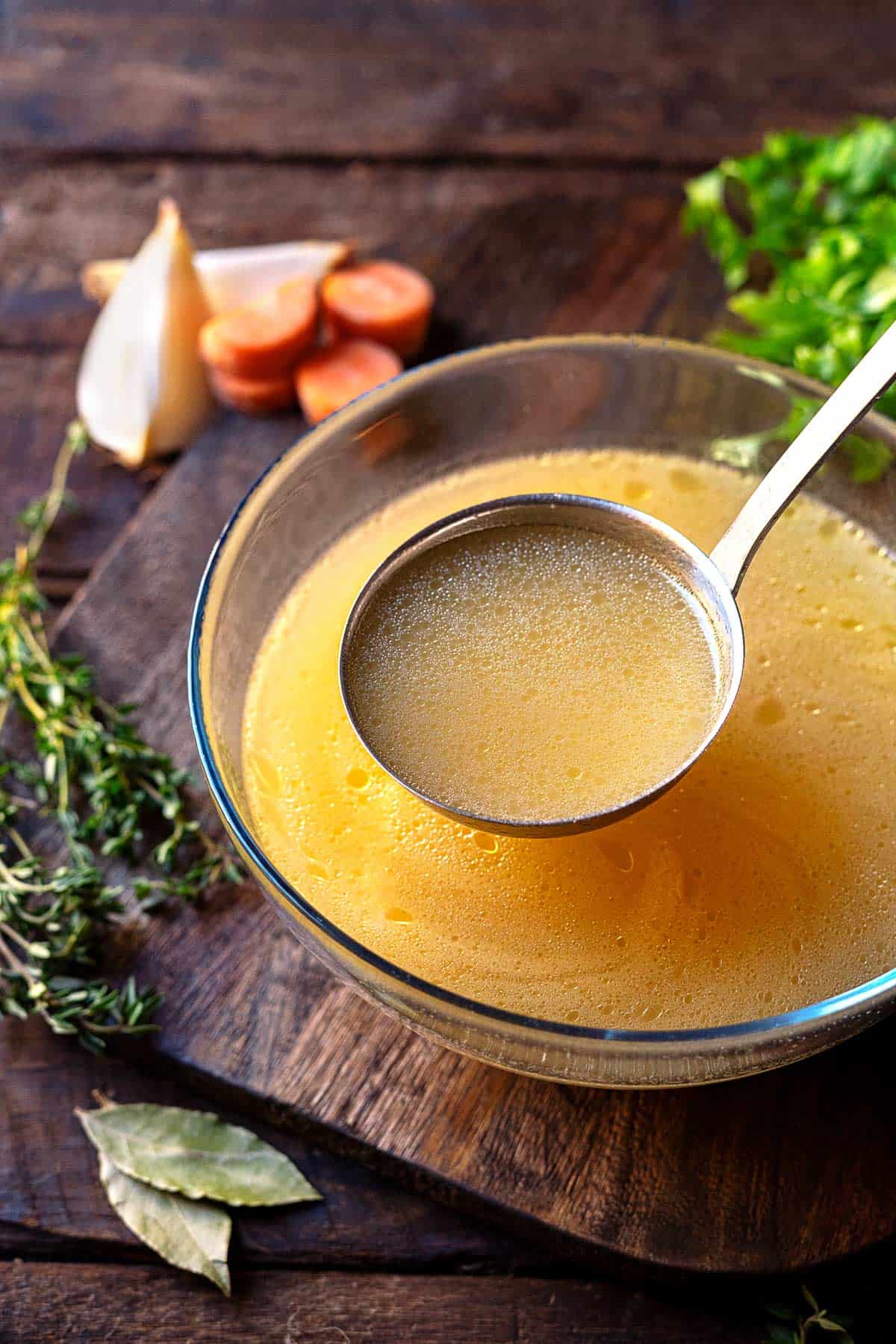
When my life was less busy and slightly quieter, I would make chicken stock while my children napped and I wrote my book or developed recipes for magazines and websites.
This was less a desire and more a need to be resourceful and pinch pennies while eating well. Simmering a batch of homemade chicken stock to use in soup recipes has since become a regular habit folded into the fabric of my life, not quite like breathing but more like making my bed or dropping my kids off at school.
Most chicken stock is made from bones and random scraps of vegetables and this recipe follows suit. You can make it in a stock pot on the stove top or in a slow cooker (more on that later).
In my home I usually add celery, onion and carrots, along with a few herbs and spices for good measure. But truthfully, there are no rules when it comes to what one can add to a pot of chicken bones. Add roasted garlic if you want it sweeter and caramelized, add ginger if you want a little bite, or fennel for a hint of anise.
Like homemade Vegetable Broth, making homemade chicken stock is an easy way to save money, use up what you have on hand and create something healthy and delicious while you’re at it. Use it in soups like Pastina, Avgolemono, White Bean and Kale Soup, Ratatouille, Chicken Gnocchi Soup, or Italian Wedding Soup. Sip on a cup of warm stock when you’re feeling under the weather or freeze it in an ice cube tray to use in pan sauces like in this Skillet Onion Chicken recipe.
Table of Contents
- What’s in Chicken Stock?
- How to Make Chicken Stock
- Chicken Stock Flavor Variations
- Tips for Making Homemade Chicken Stock
- How to Make Chicken Stock in a Slow Cooker
- What is the Difference Between Chicken Stock and Chicken Broth?
- Soothing Chicken Soup Recipes
- The Mediterranean Dish Cookbook
- How to Make Chicken Stock Recipe
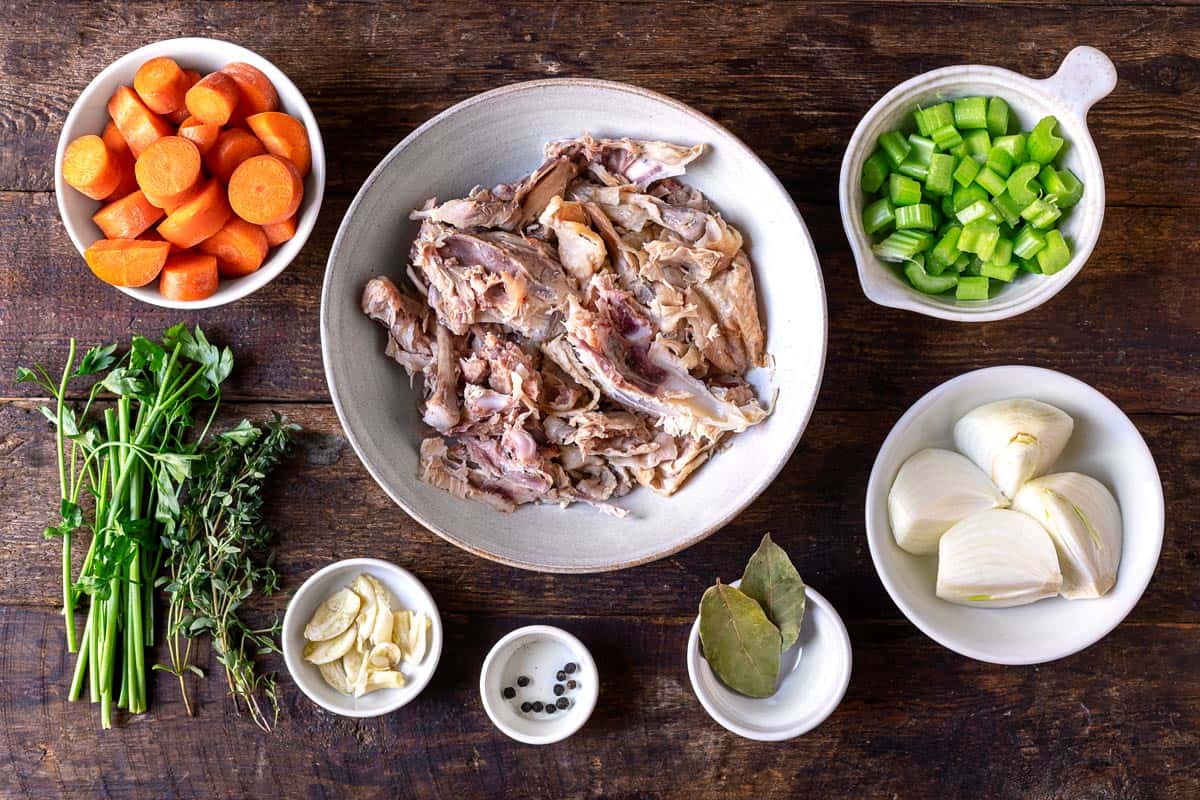
What’s in Chicken Stock?
Basic chicken stock is really just bones and water, but dressing it up with a few herbs and vegetables just increases the flavor and complexity of the stock. When I’m cooking other dishes, I often save the scraps from chopping vegetables and put them in the freezer. When I’m ready to make stock, most of the ingredients are already there.
- Chicken carcass: I roast a chicken about once a week, but you can also use a rotisserie chicken you pick up from the store.
- Celery, carrots, onion: This is a pretty classic chicken stock combination used to impart flavor and the base of many soups.
- Garlic: Technically garlic is optional, use as much or as little as you’d like.
- Fresh thyme: I like fresh thyme because it’s easier to strain from the broth and I think it leaves a fresher tasting stock. You could also use 1 teaspoon of dried thyme leaves, just not powdered thyme. It will give the stock a muddy color.
- Bay leaves: Bay leaves lend a floral sweetness to the stock.
- Parsley stems: I use the stems because they have more oils than the leaves, and stock is a great way to use them up.
- 10 peppercorns (optional): I like a little spice and I always have whole peppercorns on hand. If you have them, use them. If you don’t, that’s OK.
How to Make Chicken Stock
Learning how to make chicken stock is easy. To make homemade chicken stock, place chicken bones, vegetables, herbs and spices into a large pot. Cover with cold water then simmer for about 3 hours. Let it cool, then skim the fat. Store in the refrigerator for up to 5 days or in the freezer for up to 6 months.
- Strip the chicken carcass of meat: This is hardly delicate work. You have to be willing to get your hands dirty to pull and peel the meat off the bones. Don’t forget to flip the bird over and pull the meat from the underside. There is plenty there. Transfer the meat to a container and keep in the fridge. Use it in soup, chicken salad, or to top a bed of greens. Now to address the bones.
- Make the stock: Into a large stock pot or Dutch oven add the chicken carcass – bones, skin and any random bits. Add the chopped celery, carrots, onion, garlic, thyme, bay leaves, parsley stems and peppercorns if using.
- Cover with cold water and simmer: Pour 10 cups of cold water over the ingredients in the stockpot and turn the heat to medium, just until you see a low boil, then reduce to medium low (or whatever temp you need to keep the stove at for a gentle simmer). You want the stock to simmer and never boil for any length of time because boiling can cause the fat and proteins to emulsify and give you dark, greasy stock. Cover with a lid.
- Skim the stock: Simmer on medium low for the next 3 hours. Check every 45 minutes or so and use a spoon to skim any foam that may form off the surface. This is not an exact science. If you lose track of time, and it simmers for 4 hours that’s Ok. You’ll just have a more concentrated stock and might need to add water. If you’re short on time and you only have 2 hours then you’ll just have a lighter stock. That’s Ok too. There is no room for perfectionists in stock making!
- Strain the stock: Layer a fine mesh strainer with cheesecloth. Set it over a large bowl, then ladle the stock into the lined strainer. Press on the solids to release any additional liquid. When it’s done you should have between 5 and 6 cups of stock depending upon how much it has reduced.
- Use, store or freeze: Now that you’ve made this golden elixir with bones and scraps, use it in your next batch of soup or freeze it for a rainy day. Transfer the stock to small containers so it cools down faster. Let it cool completely then cover and transfer to the fridge. Once stock sits in the fridge for a few hours or overnight a fat layer will form on the top. Go ahead and remove that fat layer. The stock will be gelatinous and wobbly when cold. that’s a good thing. Use it within 5 days or freeze it for up to six months.
Chicken Stock Flavor Variations
Get creative when it comes to adding herbs, spices, and aromatics to chicken stock. Here are are few ideas to get you started:
- Use the base recipe here, then add 1 leek, 1 sprig of rosemary and a handful of mushroom stems
- Swap the thyme for dill
- Swap the thyme for 1 inch of ginger and a small chili or mild jalapeño
- Add chopped fennel bulb and three whole cloves
- Add crushed cardamom pods
Tips for Making Homemade Chicken Stock
I’m not too persnickety when it comes to making homemade chicken stock, but there are a few basic tips to help make your chicken stock the best it can be.
Don’t Boil Stock: It’s best to make sure stock doesn’t boil for any length of time. Bring it up to a low boil, then quickly bring it down to a simmer. Extensive boiling will cause the fat to emulsify and leave your stock dingy with a greasy mouthfeel.
Skip the Salt: Homemade chicken stock is a base recipe you can build into other recipes like soups, stews, and pan sauces. For that reason you want to leave it unsalted. Should you reduce the stock or use it in other recipes with salt then you run the risk of the dish being too salty.
Use Cold Water to Start: Cold water helps to extract more flavor from the vegetables. Hot water causes the starch in the vegetables to expand and gel, limiting the amount of flavor that can be extracted. This is a little chefy, I will admit, and the average person probably doesn’t notice, but as my mom would say, “Any job worth doing is worth doing well.”
Cool Completely: Once you’ve strained the stock, transfer it to small containers and let it cool completely. Cover and place in the fridge. Skim the fat off the top, then store for another 4 days or place in the freezer for up to six months.
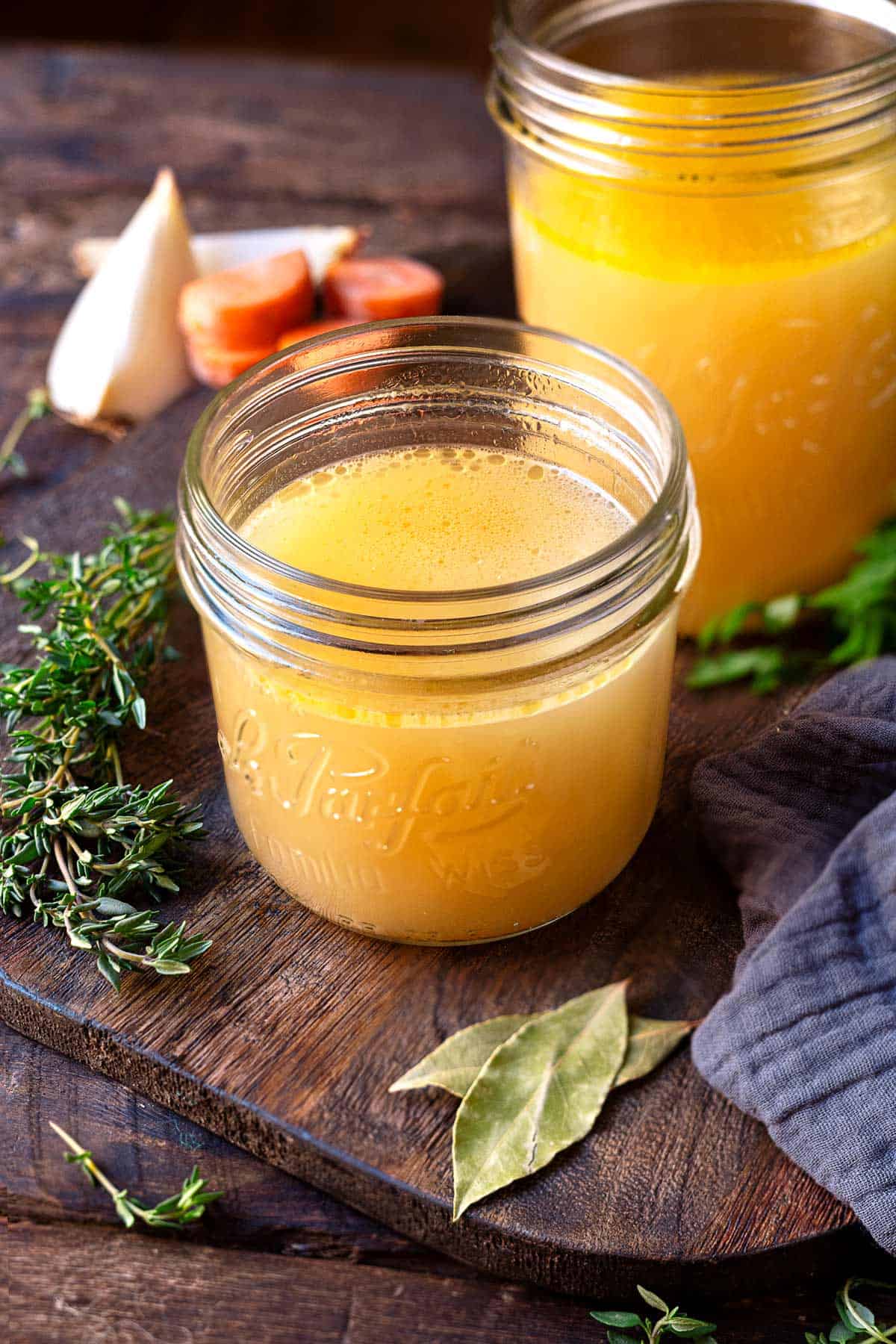
How to Make Chicken Stock in a Slow Cooker
Now that my children are older and I’m scooting them off to one activity or another, I find using a slow cooker to make chicken stock saves me time and lets me leave the house!
To make slow cooker chicken stock:
- Add all of the ingredients into your slow cooker.
- Cover with 6 cups of water and turn to high. If you’re going to be around in an hour to reduce it to low, if not, then just set it low. You don’t need as much water when making it in a slow cooker because you don’t have as much evaporation.
- Secure the lid and let it bubble away all day while you’re at work or overnight while you’re sleeping.
- When ready, pour the stock through a fine mesh strainer.
- Let it cool completely then store it in the fridge or freeze it.
What is the Difference Between Chicken Stock and Chicken Broth?
Chicken stock is made from bones and chicken broth is made from meat. Clever marketing campaigns using phrases like, “Bone Broth” (our love of alliteration is strong), can cause confusion, but if it’s made from bones it’s actually stock.
If you read chefy books or manuals you will also see a reference to salt or no salt being a defining factor in stock vs. broth. This is because technically one is used for soup, and the other is meant to be reduced for pan sauces, but really most home cooks don’t care. I skip the salt when making stock or broth and just salt the recipe I’m using it in.
Soothing Chicken Soup Recipes
Soups and Stews
White Bean and Kale Soup with Chicken
Soups and Stews
Mediterranean-Style Turmeric Lemon Chicken Soup
Soups and Stews
Lemon Chicken Orzo Soup
Browse all Mediterranean recipes.
Visit Our Shop.
The Mediterranean Dish Cookbook
Enjoy cross-culturally inspired dishes from throughout the Mediterranean using easy-to-find ingredients and easy-to-follow recipes!

How to Make Chicken Stock

Ingredients
- 1 chicken carcass
- 2 celery ribs, chopped
- 2 large carrots, chopped
- 1 onion, quartered
- 3 cloves garlic, crushed
- 4 sprigs fresh thyme
- 2 bay leaves
- Parsley stems
- 10 peppercorns, optional
Instructions
- Strip the chicken carcass of meat: Use your hands to pull and peel the meat off the bones. Transfer the meat to a container and keep in the fridge. Use it in soup, chicken chicken salad, or to top a bed of greens.
- Make the stock: Into a large stock pot or Dutch oven add the chicken carcass – bones, skin and any random bits. Add the chopped celery, carrots, onion, garlic, thyme, bay leaves, parsley stems and peppercorns if using.
- Cover with water and simmer: Pour 10 cups of cold water over the ingredients in the stockpot and turn the heat to medium, just until it begins to have a low boil, then reduce to medium low (or whatever temp you need to keep the stove at for a gentle simmer). You want the stock to simmer and never boil. Boiling can cause the fat and proteins to emulsify and give you dark, greasy stock.
- Skim the stock: Push the ingredients down to make sure they are submerged in the water and let the stock simmer on medium low for the next 3 hours. Cover with a lid. Check every 45 minutes or so and use a spoon to skim any foam that may form off the surface. This is not an exact science. If you lose track of time, and it simmers for 4 hours that’s Ok. You’ll just have a more concentrated stock and might need to add water. If you’re short on time and you only have 2 hours then you’ll just have a lighter stock. That’s Ok too. There is no room for perfectionists in stock making!
- Strain the stock: Layer a fine mesh strainer with cheesecloth. Set it over a large bowl, then ladle the stock into the lined strainer. Press on the solids to release any additional liquid. When it’s done you should have between 5 and 6 cups of stock depending upon how much it has reduced.
- Use, store or freeze: Transfer the stock to small containers so it cools down faster. Let it cool completely then cover and transfer to the fridge. Once stock sits in the fridge for a few hours or overnight a fat layer will form on the top. Go ahead and remove that fat layer. The stock will be gelatinous and wobbly when cold. that’s a good thing. Use it within 5 days or freeze it for up to six months.
Notes
- Short on time? Make chicken stock in the slow cooker. Add all of the ingredients into your slow cooker. Cover with 6 cups of water and turn to high. If you’re going to be around in an hour, reduce to low. If not then just set it to low at the outset. Secure the lid and let it bubble away all day while you’re at work or overnight while you’re sleeping. When ready, pour the stock through a fine mesh strainer and cool.
- Cheesecloth: I like to use cheesecloth just for an extra layer of straining, but if you don’t have any a fine mesh sieve will do just fine all on its own.
- Visit our shop to browse quality Mediterranean ingredients including olive oils, honey, jams and spices.



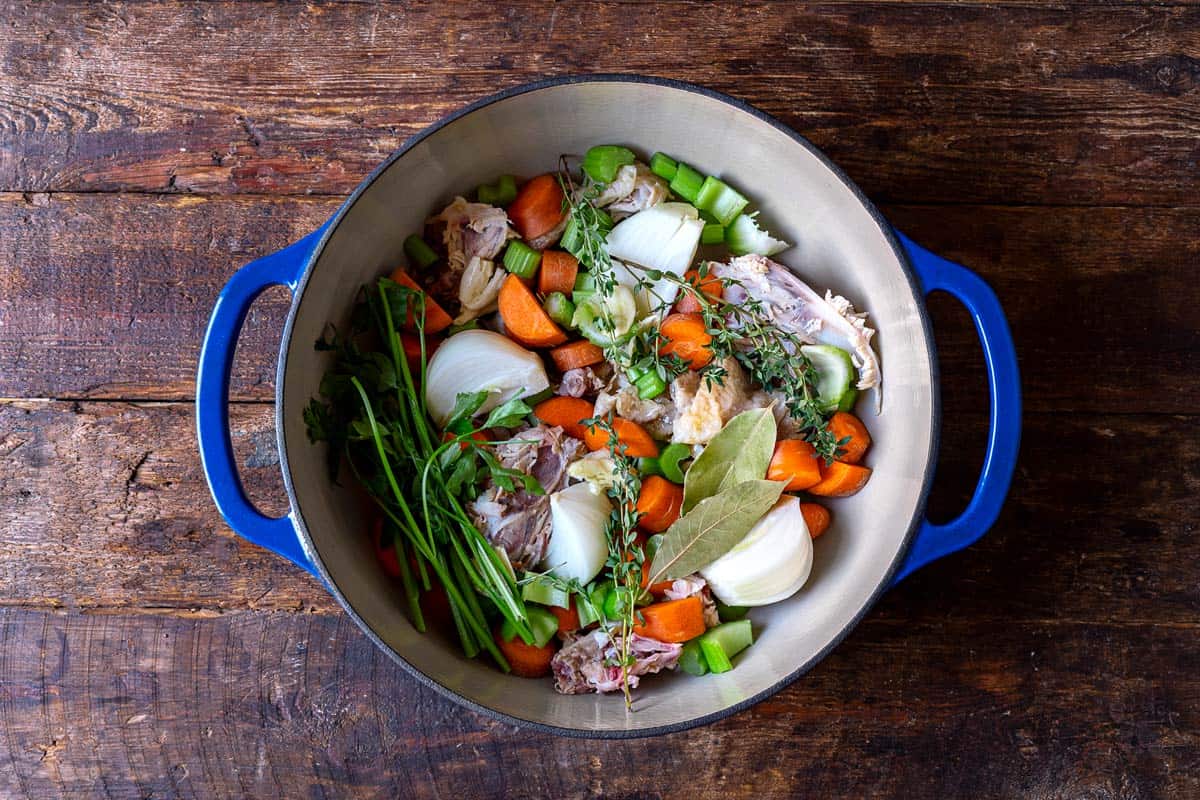
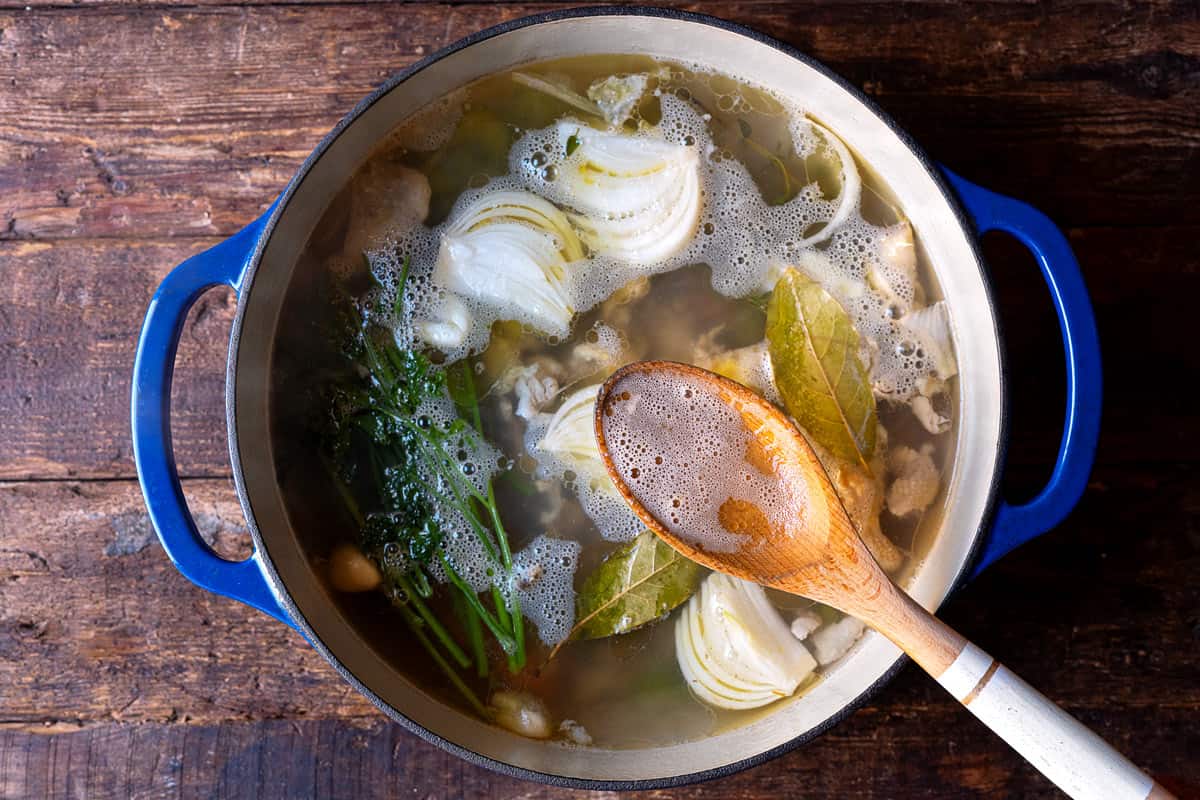
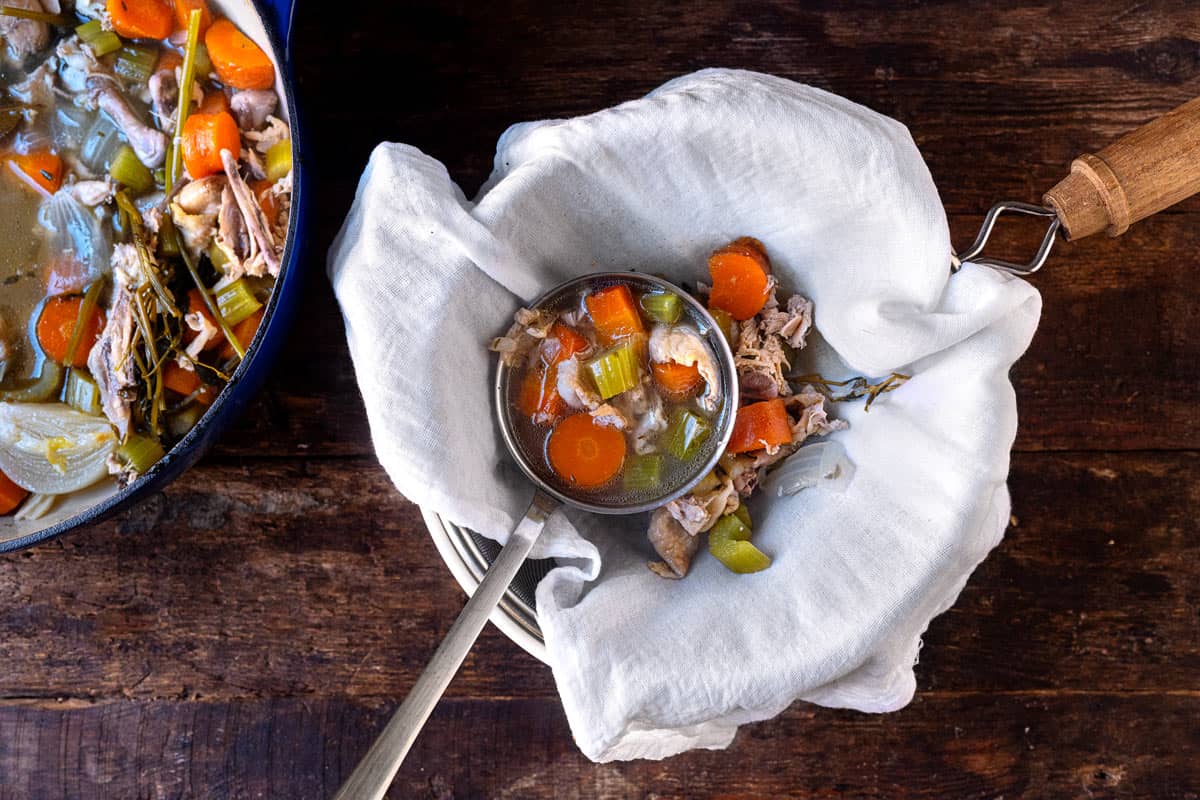
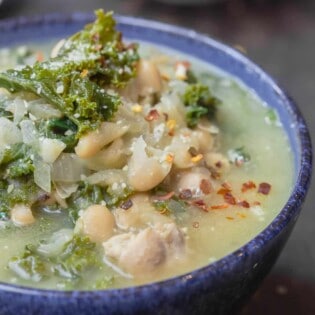



Hello! I’m making stock for the first time. I only used a chicken carcass, carrots, onion, celery and garlic. I didn’t have any of the herbs or peppercorn on hand. Is that okay?
Also, I accidentally let it slightly boil a bit since I’m guesstimating the right temperature to let it simmer properly. Will this affect the final product negatively?
Thanks!
Hi, Shania. Without the spices, it may turn out a bit bland. Next time, you may at least what to add a bit of salt and black pepper. And it’s okay that it boiled slightly by accident. You may have just ended up with a stock that is darker in color and a bit more greasy.
Great recipe and wonderful suggestions for making this on a routine basis.
Thank you for this great recipe just a quick question to clarify:
What do you do with the liquid in which the chicken has been cooked?
Thanks so much for your response
Hi, Colleen. You can use that liquid in place of some of the water for extra tasty stock :).
Made this yesterday and it came out great! I actually added too much water by not trusting the process and I thought there wasn’t enough water. Well, after 3 hours it really just tasted like bland chicken water so I removed the lid and continued for another 4-5 hours and cooked off some of the water and it was so much better! Trust the process lol, it’ll be great!
Hi. I will try this after our next Sunday roast. A quick question though – how much of the stock should you use for one batch of soup? Commercially bought stock ‘pods’ will say something like one pod per 250ml of water, or similar. Would you use the stock from this recipe as it is, undiluted, for one portion? Or grab a cup of it and dilute with water for several soups?
Thanks.
Hi, Jon. For this recipe can use the stock exactly as it’s written. No need to dilute it to use in soups. The exact amount will depend on the particular recipe you’re following. Hope you enjoy it!
This is a great recipe. I use an uncooked carcass after removing the pieces because a cooked chicken has already rendered much of its flavor and fat. And I leave out the garlic – I’m not making soup. Seasoning is for the dish.
Just wanted to say that the stovetop method made a wonderful, delicious broth. I’ll try it in the slow cooker next time. Great recipe with lots of helpful tips. Thanks.
I have a 6 qt slow cooker. Is this too big for making broth with only one chicken carcass? If using 2 carcasses, would I just double the ingredients?
Hi, Joanne! I’m Summer and I work here at The Mediterranean Dish. A 6qt slow cooker is just fine for making broth with only one chicken carcass. Making broth/stock is very forgiving. Use what you have and it will taste great. You don’t necessarily need to double all of the ingredients as the carcasses will likely take up quite a bit of space, your stock will just more concentrated and have a stronger chicken flavor. If you want to add more herbs/aromatics you certainly can. Enjoy!
Hi! When I made this, our cup sizes are 250g I did 10 and it just about covered it, I left it simmering un covered in a pan for 2 and a half hours and there is barely anything left! Where have I gone wrong here?
Thanks!
Hi, Sacha! I’m Summer and I work here at The Mediterranean Dish. Your heat may have been a little high or your stock pot a little wider and it just evaporated quickly. But don’t worry! You can still save it! Next time just cover or partially cover your pot when making stock and if you see that it’s reducing quickly, don’t be afraid to add a little more water from time to time. And as for this batch, you now have really concentrated stock. You can just add water to the stock you have, taste as you go so you don’t dilute the flavor to much. Or you can add more water to the pot with the bones and vegetables then simmer again. I am also a big fan of the slow cooker method I mention in the article that precedes the recipe. I hope this helps! Good luck!
Hi, Is it necessary to skim off the fat? Thanks!
Hi, Susan! Skimming off the fat can result in a clearer, cleaner-tasting stock, as excess fat can add greasiness to the final product. However, some people prefer to leave the fat in for added flavor and richness, and that’s totally okay. Ultimately, whether or not you skim off the fat is up to you and your preferences.
I make a lot of homemade soup which calls for broth so I was searching on line to make it homemade as I dislike the ingredients and taste of store bought broths. The one thing I do NOT understand, is the fat difference. When you buy broth in the store it is like minimally flavored colored water; whereas the STOCK is so much fattier due to the fats & collagen that come off of the carcass. So is the BROTH that you buy in the store strictly strained chicken meat & water (with flavors) but without the carcass? I am concerned this thicker chicken STOCK will be too heavy in my soup recipes, so should stock be watered down to make it into broth for my recipes? All of my soup recipes call for 32 oz. (4 cups) of broth. So what about mixing a broth/stock recipe. Using the broth from cooking a whole chicken and adding that to the STOCK recipe. This would water it down quite a bit but still have the carcass ingredients mixed in with the broth of the cooked chicken. Sorry for the long winded question; hopefully you can shed some light. : )
Hi, Linda! It’s difficult to say what happens with store bought broth or how its made. As for this recipe, you can use it exactly as it’s written. No need to thin or water it down to use in soups. If anything, it will provide an enhanced velvety mouthfeel. When the stock is cold in the fridge, it will look gelatinous, but don’t worry it liquifies beautifully when heated on the stove. I hope this helps.
Simmer with lid or no lid?
Hi, Sarah. You can simmer this without the lid.
What about the scum when using a slow cooker?
I’ve read several slow cooker broth stock recipes and it’s never mentioned when it’s stressed in recipes on the stove….?
Hi Kara, Devin here from the Mediterranean Dish team. You can absolutely make this in your slow cooker–see instructions here. The extra-gentle nature of the slow cooker means less agitation and fewer impurities, so there’s no need to skim. Let us know how it turns out!
Hi! Is the chicken cooked when you pull off the meat? Can I use a store bought roasted chicken?
Hi, Jamie! I’m Summer and I work here at The Mediterranean Dish. I have routinely used rotisserie chicken that I’ve picked up at the grocery store for this recipe. So yes, you can roast a chicken (or pick one up from the store) eat the meat, then use the bones/carcass in this recipe to make chicken stock. However, you can also use uncooked bits and pieces (for example if you spatchcock chicken) go ahead and use the uncooked backbone to make chicken stock. Either will work. It simmers long enough.
If you have the hours to devote to homemade stock, certainly you can find time to roast a chicken, so easy, just throw it in the oven and walk away, 20 mins per lb. SO much healthier than store bought rotisserie chicken, filled with chemicals from its “injection solution”. I can taste the awfulness after just one or two bites. The sodium alone is a high blood pressure risk. Be smart. Homemade stock is wonderful for you, but not if you start with unhealthy ingredients, i.e. rotisserie chicken.
Hi, Laura! I do often roast a whole chicken at home. I have a great recipe for it on this site for Whole Roasted Chicken should you want to give it a try, but sometimes life gets in the way and if I have to rush dinner, I will take a rotisserie chicken over a frozen pizza any day of the week. That’s the beautiful thing about cooking. We can all create ways to make it work for us no matter the stage in life.
I never knew how easy making stock was! The amount of flavor this homemade stock gives a dish versus store bought is unbelievable. Thank you for the great recipe!
It really does make a difference! Thanks so much, Amber!